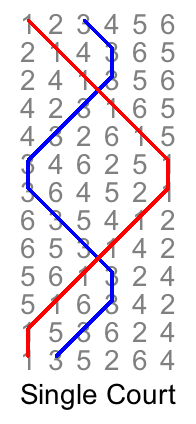
I have been thinking about how to understand the internal structure of methods by viewing them as compositions. This isn't particularly related to handbells, except that some of the methods I'm going to look at are methods with simple structures that make them easy for handbell ringing.
To see what I'm getting at, let's start with Single Court Bob Minor. It's well known that a plain course of Single Court can be viewed as a touch of Original (recall that Original is plain hunting with bobs, place notation 14, possible in place of any 16 place notation). How does this work?
The coursing order of plain hunting, including the treble, is 124653. At the beginning of a lead of Single Court the 3rd makes 4ths, which is a bob, and the coursing order becomes 124365 as the 3rd jumps over the 5th and the 6th. This is an ABC -> CAB transposition because the 14 bob replaces a 16 place notation.
At the end of the lead the 3rd makes 4ths again, which is another bob, and the coursing order becomes 132465 as the 3rd jumps over the 2nd and the 4th.
Notice that excluding the treble we now have the coursing order 32465 which is a rotation of the initial coursing order 24653. We have a five-part composition. The part end is 135264, which is the first lead end of Single Court.
If we think of the 3rd making the bob twice, we know that in Plain Bob Minor this would return to the plain course. However, because we are including the treble in the coursing order, the situation is more like calling a bell to make the bob twice in major (think of the treble in Original as like 78 in a major method). For example, calling a wrong and then a middle to produce the coursing order 32465.

Now let's think about Double Court. After making 4ths, the 3rd makes 3rds, which is like another bob but this time on the front. The 3rd jumps over the 2nd and the 4th. The coursing order, starting from 124653, becomes 124365 and then 132465. That's the same overall transposition as before, but now it has been achieved before the treble reaches the back. The half lead of Double Court therefore has the non-treble bells in a cyclic rotation of their initial coursing order, and if we think of Double Court as a method with the treble plain hunting, we see that the bells are in coursing order at the half lead and the half lead row is one of the half lead rows from Plain Bob.
In the second half of the lead, a different bell makes 3rds and then 4ths. It's the 5th. The coursing order becomes 132546 and then 153246. Again the non-treble bells are in a cyclic rotation of their initial coursing order, so the lead end is one of the Plain Bob lead ends, 156342.